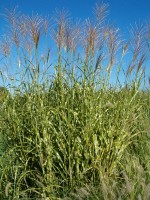 For long season interest consider the warm weather Zebra grass, a native of Japan, Korea and China. It is a member of the grass family, Poaceae, that also includes corn, rice, and bamboo. The grass grows in tight rounded clumps beginning in spring and reaches 5-6’ by mid-summer. Its long, arching leaves are horizontally striped with wide bands of cream and green and add both color and texture to the back of the border. By mid September the grass reaches 6-8’ when its fluffy pink to copper tinted blooms rise above the still attractive foliage. As fall progresses the blooms turn silvery white and the foliage turns a golden yellow on its way to brown. Leaving the plant through the winter not only adds to the garden scene, it also protects the crown so that the plant can arise again in spring. Throughout the entire growing season the clump stays attractive even as it increases in circumference. Even heat, humidity, drought, or salt spray do not mar the beauty of this grass once it is established. Zebra grass is an attractive addition to coastal, cottage, and praire gardens and can be used as a speciman or hedge. The genus name, Miscanthus, comes from the Greek words mischos meaning stalk and anthos, meaning flower and refers to the inflorescence. The specific epithet, sinensis, is the new Latin word meaing from China, referring to the plants origin.
For long season interest consider the warm weather Zebra grass, a native of Japan, Korea and China. It is a member of the grass family, Poaceae, that also includes corn, rice, and bamboo. The grass grows in tight rounded clumps beginning in spring and reaches 5-6’ by mid-summer. Its long, arching leaves are horizontally striped with wide bands of cream and green and add both color and texture to the back of the border. By mid September the grass reaches 6-8’ when its fluffy pink to copper tinted blooms rise above the still attractive foliage. As fall progresses the blooms turn silvery white and the foliage turns a golden yellow on its way to brown. Leaving the plant through the winter not only adds to the garden scene, it also protects the crown so that the plant can arise again in spring. Throughout the entire growing season the clump stays attractive even as it increases in circumference. Even heat, humidity, drought, or salt spray do not mar the beauty of this grass once it is established. Zebra grass is an attractive addition to coastal, cottage, and praire gardens and can be used as a speciman or hedge. The genus name, Miscanthus, comes from the Greek words mischos meaning stalk and anthos, meaning flower and refers to the inflorescence. The specific epithet, sinensis, is the new Latin word meaing from China, referring to the plants origin.
Type: Perennial grass.
Bloom: Feathery, copper tinted inflorescence in fall; grown also for cream and green striped foliage that is attractive from spring until frost.
Size: 7-8′ H x ever expanding girth.
Light: Full sun to part shade
Soil: Average, moderately moisy, well drained
Hardiness: Zones 5-10
Care: Cut back in early spring.
Pests and Diseases: Generally healthy but mealy bug and blight can be a problem.
Propagation: Division in spring (spreads by rhizomes)
Companion plants: Sedum x telephium ‘Autumn Joy’, Rudbeckia fulgida var. sullivantii ‘Goldsturm’, Mexican sunflowerm(Tithonia rotundifolia), canna ‘King Humbert’ orange).
Photo Credit: Wikipedia
